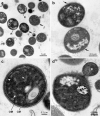Stieleria tagensis sp. nov., a novel member of the phylum Planctomycetota isolated from Tagus River in Portugal
- PMID: 37737556
- PMCID: PMC10541342
- DOI: 10.1007/s10482-023-01877-2
Stieleria tagensis sp. nov., a novel member of the phylum Planctomycetota isolated from Tagus River in Portugal
Abstract
A bacterial strain was isolated from a brackish water sample of Tagus river, Alcochete, Portugal and was designated TO1_6T. It forms light pink colonies on M13 medium supplemented with N-acetylglucosamine. Cells are pear-shaped to spherical, form rosettes and divide by budding. Strain TO1_6T presents a mesophilic and neutrophilic profile, with optimum growth at 20 to 25 °C and pH 7.0 to 7.5, and vitamin supplementation is not required to promote its growth. The genome of the novel isolate is 7.77 Mbp in size and has a DNA G + C content of 56.3%. Based on its 16S rRNA gene sequence, this strain is affiliated with the phylum Planctomycetota. Further taxonomic characterization using additional phylogenetic markers, namely rpoB gene sequence (encoding the β-subunit of the DNA-dependent RNA polymerase), as well as Percentage of conserved proteins, average nucleotide identity and average amino acid identity, suggest the affiliation of strain TO1_6T to the genus Stieleria, a recently described taxon in the family Pirellulaceae, order Pirellulales and class Planctomycetia. Based on the genotypic, phylogenetic and physiological characterization, we here describe a new species represented by the type strain TO1_6T (= CECT 30432T, = LMG 32465T), for which the name Stieleria tagensis sp. nov. is proposed.
Keywords: Brackish water; Genomic identification; Mesophilic aerobic bacterium; Pirellulaceae; Planctomycetota.
© 2023. The Author(s).
Conflict of interest statement
The authors declare no competing interests.
The authors declare that there are no conflicts of interest.
Figures



References
-
- Alcock BP, Raphenya AR, Lau TTY, Tsang KK, Bouchard M, Edalatmand A, Huynh W, Nguyen AV, Cheng AA, Liu S, Min SY, Miroshnichenko A, Tran HK, Werfalli RE, Nasir JA, Oloni M, Speicher DJ, Florescu A, Singh B, Faltyn M, Hernandez-Koutoucheva A, Sharma AN, Bordeleau E, Pawlowski AC, Zubyk HL, Dooley D, Griffiths E, Maguire F, Winsor GL, Beiko RG, Brinkman FSL, Hsiao WWL, Domselaar GV, McArthur AG. CARD 2020: antibiotic resistome surveillance with the comprehensive antibiotic resistance database. Nucleic Acids Res. 2020;48(D1):D517–D525. doi: 10.1093/nar/gkz935. - DOI - PMC - PubMed
MeSH terms
Substances
Grants and funding
LinkOut - more resources
Full Text Sources
Miscellaneous

